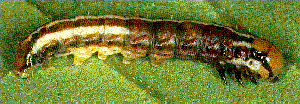Common Stalk Borer
Common Stalk Borer
Description
Small larvae are cream-colored with a dark brown or purple band around the body. Several brown or purple lengthwise stripes may be present.

Common stalk borer
University of Kentucky Dept. Entomology
Adult moths are grayish brown with small white spots along the front and tips of their forewings. The hindwings are a pale gray-brown. Wing span is about one inch.
Damage
Damage is greatest in weedy border rows. The stalk borer will tunnel deep into the whorl leaves of the corn. This results in the unfolding leaves having irregular holes and ragged edges and the upper leaves may wilt or die. Sawdust-like feces can be seen in the whorl or coming out of the entry hole in the stalk. Unrolling the whorl will usually reveal the borer.
IPM Techniques and Scouting Procedures
- The stalk borer has appeared as early as May 31, but normally it is not observed till mid-June. Cultivated crops near weedy areas,especially ragweed, are most often attacked. Damage is usually minimal in conventional minimum-till fields, but can be a problem in no-till fields. Corn plants from 24 inches tall will be attacked.
- Check 20 plants at each location. Record the average number of stalk borers found per location on the report form. You may also want to check around border rows of conventionally tilled fields in May and June. In no-till fields a random check throughout the field is necessary.
- Economic Threshold: An economic threshold has not been established. A "rescue" insecticide treatment will rarely be effective. Control is only possible if the insecticide is applied when the larvae are moving from the weeds to the corn seedlings. Treatments applied after the larvae have entered the corn plants are not effective.
- In conventional corn, killing grasses and weeds along field edges by mowing, burning or using herbicides will aid in controlling the borer. However, avoid weed removal while the borers are active between planting and early July. Similarly, stalk borer numbers can be reduced in no-till corn by reducing the number of weeds.
References and Additional Information
- IPM-2 Kentucky IPM Manual for Corn
- ENTFACT 100 - The Common Stalk Borer in Corn


